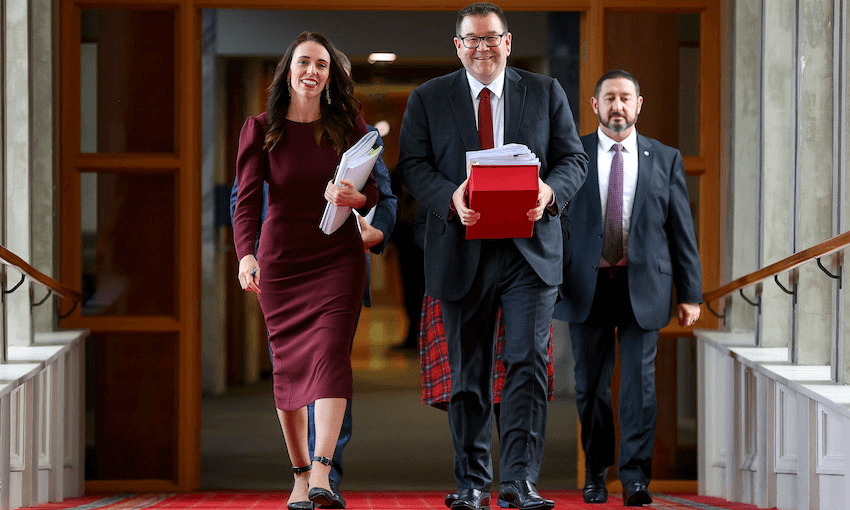The budget saw plans to design a new scheme to protect those who fall out of work. Justin Giovannetti explains how it might work.
The government is designing a new addition to the country’s welfare net, a social unemployment insurance programme to help workers keep most of their wages after they lose their jobs.
By itself the programme, which is being worked on with Council of Trade Unions, is a significant change, however, along with the move to sector-wide wage bargaining announced two weeks ago, it’s part of a massive change to what employment will look like in New Zealand. And perhaps more importantly, what losing employment will feel like.
What exactly is it?
The idea is that someone should be able to support themselves and keep up a reasonable standard of living through a short stint of unemployment. The system would pay out 80% of a worker’s wages, but there would be a cut-off so the truly wealthy wouldn’t drain the system if they found themselves on the curb.
Mirroring the model used by ACC, the insurance programme would be funded through money taken off a worker’s pay-cheque and topped up by their employer. The idea is that it shouldn’t cost the Treasury much if anything. This type of insurance system is pretty common in the Nordic countries and Canada uses a similar model.
How is this different from jobseeker?
The benefit, which just got increased in the budget, pays most people the same amount. It varies based on whether you’re in a couple or if you have kids.
Unemployment insurance is based on how much money you’ve made in the past. The system in Canada is less generous than the one being proposed by finance minister Grant Robertson and pays out 55% of someone’s earnings up to $56,300. A worker earning that much would pay about $800 annually in premiums, with their employer adding another $1,200. The US and UK have stingier systems.
A lot of the details here haven’t been finalised, so it’s not clear how much it would pay or when. The current plan is to have this finished by 2023.
Is there more than just money?
Denmark operates a programme closer to what Robertson has proposed, paying out 80% of a wage and also adding training requirements for workers. Robertson has said a training component will be built into unemployment insurance here.
The Danish system is also incredibly expensive, costing nearly four times more than the average rich country spends on welfare. In exchange for the largesse, it sets incredibly strict requirements on the unemployed to actively search for a job and ruthlessly enforces them.
So does this get rid of the benefit?
All these programmes are time-limited. In Canada it lasts 50 weeks, mostly because it was bumped up because of Covid-19 and increasing unemployment. In some US states it only lasts a few months.
Once that time is up, you’d be bumped onto the benefit.
So is this good for rich people?
Countries that tend to run both an insurance programme and a benefit funded by taxpayers generally run into a conflict. The insurance programme pays out a good wage for the wealthier unemployed, who often find new jobs faster, while low-paid or low-skilled workers end up on the much worse benefit faster.
The argument from prime minister Jacinda Ardern is that it’ll stop “economic scarring”. That’s an economic phenomenon that shows that when people lose their jobs, especially in times of economic crisis, the impact on their incomes can last the rest of their careers. Paying them unemployment insurance can help stop the damage by maintaining their standards of living.
It’s also a good deal for the Treasury. This will become the first line of defence for people who lose their jobs and it makes losing your job less scary. You’ll have a little less money than you’re used to, but not that much less, so you can focus on finding work or even take a moment and think about retraining.
One aspect of the design that will be important is who controls the big pot of money set aside to pay the unemployed. Nearly everyone pays into it, and in good years very few people use it. In Canada, it has been an irresistible target for finance ministers, who’ve raided the fund in good years to pad their budgets. Then in bad years, they cut back on benefits if they drained a bit too much.
Will this get rid of the Covid-19 wage subsidy?
One of the main reasons to do this, according to the government, is to stop the need to create wage support programmes during each economic crisis. The government had to do it after Covid-19 and the global financial crisis.
Making support more predictable is a laudable goal and will hopefully ease the concerns of workers facing a tough time. However, the international evidence is pretty bad on this one. Many countries with unemployment insurance programmes have had to extend them or make them better during Covid-19 because unemployment got bad and few were hiring in the midst of a lockdown. That’s really not all that different from the wage subsidy.
Follow When the Facts Change on Apple Podcasts, Spotify or your favourite podcast provider.

